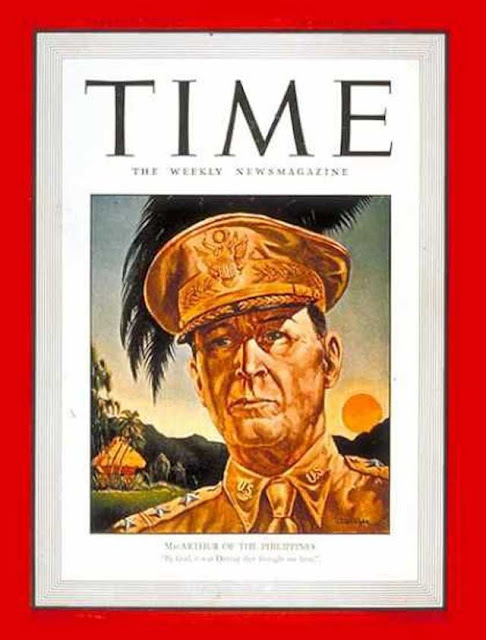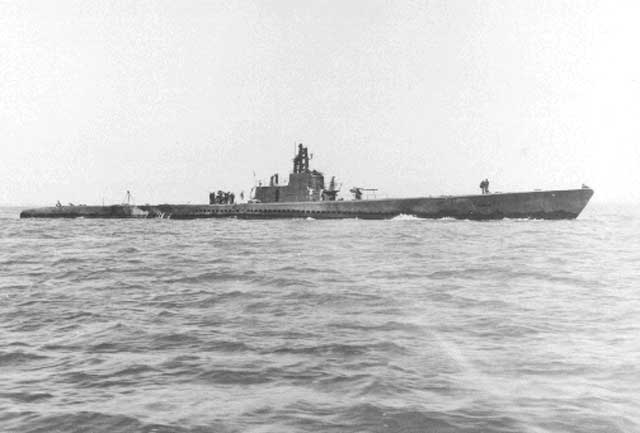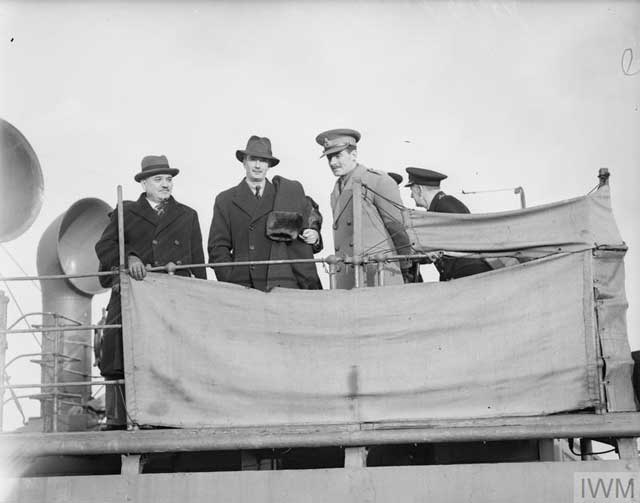Wednesday 26 February 1941
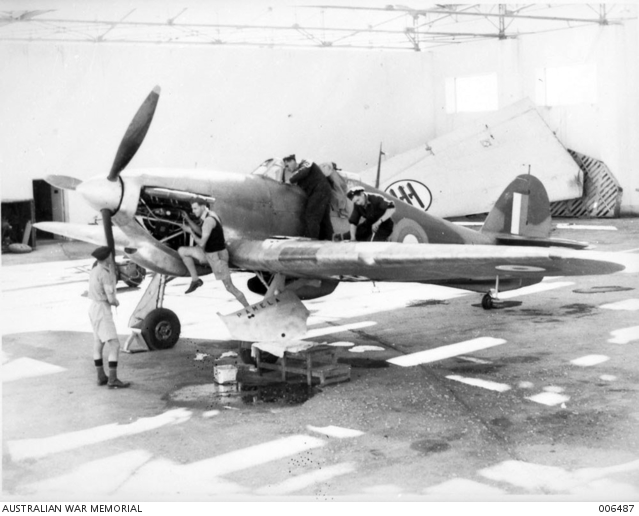 |
| A No. 3 Squadron Hawker Hurricane. It is in a roofless hanger at Benina. Shown, from left to right, are Sergeant M. Quinton of Windsor, Corporal R. Stephen of Sydney, Corporal H. Thomas of Sydney, and Aircraftman I W.H. Heiler of Sydney. Note the wing of a downed Italian plane in the background (Photo by Frank Hurley, AWM 006487). |
Italian/Greek Campaign: The Albanian front is quiet on
26 February 1941. Both sides are under pressure to make advances, the Italians to salvage some national pride after a terrible winter of military reverses, the Greeks to expel the Italians to free up forces to defend against an anticipated German invasion.
East African Campaign: The 11th African Division occupies Mogadishu in force today, with the 7th Field Brigade taking up billets in the Motor Transport Park. The troops find a city in crisis, full of shallow graves, unburied corpses, and generally unsanitary conditions. The 12th African Division, meanwhile, continues moving up the Juba River and gradually reduces remaining Italian columns. They Take the road junction at Tassin and take up positions at Modun and Brava. The British advance is hampered more by lack of adequate water and fuel supplies than anything the fleeing Italians are doing.
 |
| Focke Wulf Fw 200C Condor of 1.KG40-(F8+GH), Bordeaux, France, 1941. |
European Air Operations: The RAF conducts a Circus operation over Calais. There are a dozen Blenheim bombers with a heavy fighter escort. The dogfights swing back and forth on both sides of the Channel. After dark, RAF Bomber Command attacks 126 bombers against Cologne.
The Luftwaffe's activity during the day is light, with a few scattered bombs dropped in Kent and East Anglia. At night, the German attacks largely focus on towns in Wales, primarily Cardiff. The damage at Cardiff is fairly heavy, concentrated on the docks, St. Martin's Church, and parts of Violet Street. The railway lines nearby are not damaged. There are several deaths and two firemen fighting fires at the docks are injured.
The RAF is swapping out front-line units to give them a rest and refit. Today, RAF No. 65 flies north and trades its new Supermarine Spitfire Mk IIs for older Mk IAs at Kirton. The planes go to RAF No. 616 Squadron, which takes No. 65's place on the front lines at RAF Tangmere.
Werner Mölders, Kommodore of JG 51, continuing his recent roll of victories after a long vacation, claims No. 60 today during the operations over Calais. Fellow ace (
experten) Hans-Karl Keitel (8 victories) perishes in the action.
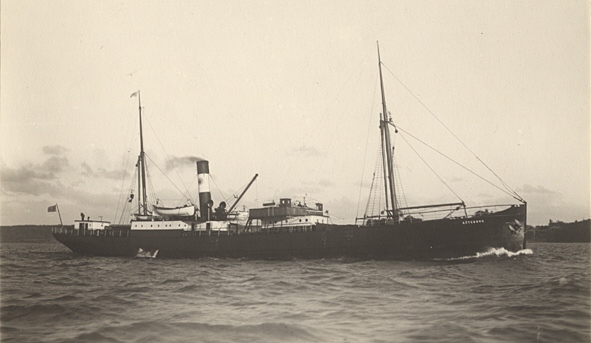 |
| Swedish freighter Göteborg, lost today with all hands (Photo courtesy of Sjöhistoriska Museet, Stockholm). |
Battle of the Atlantic: The Germans have become active against the convoys again, and their efforts are producing results. Recently, OB-289 was devastated by U-boat attacks. While U-boats gain fame, the Luftwaffe also contributes greatly to the blockade effort at this point in the war, as they prove today.
Convoy OB 290 is heading west and is south of Iceland when the Germans attack. The convoy disperses after the first U-boat attacks, but that does not help its ships.
U-47 (Kptlt. Günther Prien) starts the ball rolling at 01:37. Prien goes to work as only he can:
- 5254-ton Belgian freighter Kasongo (sunk, 6 deaths)
- 3636-ton Norwegian freighter Borgland (sunk, all survive)
- 3197-ton Swedish freighter Rydboholm (sunk, 28 survivors)
- 8106-ton British freighter Diala (1 dead, damaged, makes port).
The Rydboholm becomes a flaming wreck, abandoned by its crew. The derelict eventually is sent to the bottom by the Luftwaffe. In all, Prien's U-47 helps to sink three ships of 12,087 tons.
Prien calls for help (he is a master at stage-managing convoy destructions). Help indeed is available, both from other U-boats (U-73, U-97, Italian submarines Michele Bianchi and Barbarigo) and the Luftwaffe.
Focke-Wulf Fw 200 Condors of I,/KG 40 first arrive around noontime. There are multiple attacks throughout the afternoon. The attacks are pressed home at wavetop level with great daring. This is a classic action, the type you think about when reflecting on Condor attacks at sea (if you ever do that sort of thing, like me).
The Condors get credit for sinking:
- 7181-ton British freighter Mahanada (three deaths)
- 4659-ton British freighter Swinburne (all survive)
- 4966-ton British freighter Llanwern (25 deaths)
- 4340-ton Greek freighter Kyriakoula (all survive)
- 2580-ton Norwegian freighter Solferino (3 deaths)
- 4368-ton Dutch freighter Beursplein (21 deaths, the ship sinks on the 27th after the crew finally abandons ships).
In addition, 5273-ton British freighter Melmore Head is damaged. The crew abandons ship, and it later is towed into Rothesay Bay and beached. Another victim is 4758-ton British freighter Leeds City, which eventually is towed into the Clyde. A third damaged ship, 7915-ton Dutch freighter Suriname, makes it into St. Michaels apparently under its own power. Swedish 4719 ton freighter Samuel Bakke is bombed and strafed (and also may have shot down a Condor), but is able to continue with the convoy to Halifax.
Also joining the attack on Convoy OB 290 is Italian submarine Michele Bianchi (Capitano di corvetta Adalberto Giovannini). Captain Giovanni makes the Bianchi one of the more aggressive Italian boats. Today, it sinks 6803-ton British freighter Baltistan. There are 51 deaths and 18 survivors from Baltistan. Some accounts place this sinking on the 27th.
U-70 (Kptlt. Joachim Matz) is operating south of Iceland on its first (and, as it turns out, only) patrol. Matz spots 820-ton Swedish freighter Göteborg and sends it to the bottom. All 23 men on board perish. Since there are no survivors, and also no survivors from U-70 when it is sunk later on this patrol, the encounter is likely based on the circumstances, but still, conjecture.
German E-boats have been active recently. Today, they patrol off Cromer in the North Sea and claim another victim. S-28 sinks 1123-ton British freighter Minorca. There are 19 deaths and three survivors. S-28 tries to take the ship in tow, but it sinks.
The Luftwaffe bombs and sinks 5655-ton Norwegian freighter Teneriffa at the mouth of Bristol Channel. All 37 men on board survive.
The Luftwaffe bombs and damages 8156-ton Dutch freighter Amstelland in the Northwest Approaches. The Amstelland is taken in tow but sinks on the way back to port.
The Luftwaffe bombs and damages 7744-ton British freighter Empire Steelhead. The ship is taken in tow but is a blazing inferno. While usually a damaged ship would be taken to the dock, the Empire Steelhead is watertight and is put at an anchorage off Invergordon to wait for the fires to abate.
British power barge Brackelier is towing barge Monarch at Hull when together they hit a mine. They both sink just off Alexandria Jetty near the dock. The mines were laid by IX Air Korps. There are three deaths.
German lugger Schaumburg-Lippe hist a mine and sinks in the Ems River.
Royal Navy destroyer HMS Georgetown collides with another ship but makes it to the Clyde. It will be under repair in the Tyne for several months.
Three Royal Navy destroyers lay minefield JL in the English Channel. In another minelaying operation by RAF No. 812 Squadron, a Swordfish crashes, killing the crew.
Convoy WN91 departs from Gourock, Scotland,
Royal Navy corvette HMS Convolvulus (K45, Lt. Richard S. Connell), Flower-class, is commissioned.
U-85 and U-408 are launched.
 |
| The devastation after bombs hit Partridge Street, Cardiff in 1941 (Wales Online). |
Battle of the Mediterranean: The British still occupy Kastellorizo, having invaded the island with about 200 commandos on the 25th. However, there have been several problems with Operation Abstention, such as poor communications and failure to land most of the planned troops for one reason or another. The Italians have a major base relatively nearby in Rhodes, and the Regia Aeronautica has been punishing the occupying British forces and the Royal Navy ships standing offshore. The situation remains relatively stable until shortly after sunset when Regia Marina torpedo boats Lince and Lupo land about 240 soldiers north of the port. They bring with them 99 mm artillery, which they use to shell the port and kill three and wound seven commandos. The Italian boats then evacuate some Italian civilians.
The British commandos are forced by the Italian bombardment to abandon the port and retreat to their landing point near Cape Nifti. They inform the destroyers Hereward and Decoy standing offshore about the Italian landings, but they are too far away to intervene until the Italian landings are over and the Italian ships have departed. Other British troops (Sherwood Foresters) are on armed yacht HMS Rosauro and could be landed to help the commandos, but due to the difficult situation onshore, those landings are canceled.
The operation rapidly descends into chaos for the British commandos. They never were intended or supplied to hold a position indefinitely; instead, the plan was for them to seize key facilities, then hand off to well-prepared and supplied static troops. As night falls, they are isolated without shelter or food and subject to bombardment by the Italian guns. They can do nothing but wait for evacuation.
Offshore, there are Italian and Royal Navy ships near the island, but for the most part they are just ships passing in the night. The British naval part of Operation Abstention is Operation Mar2, and there are several destroyers ready for action. HMS Hereward does see the Italian ships but loses contact before it can team up with HMS Decoy to mount an attack. Destroyer HMS Jaguar is fired upon by Italian destroyer Crispi, including two torpedoes which do not hit. The action is confused in the darkness, and the Crispi gets a lucky shot which puts out the Jaguar's searchlight, making her firing ineffective. Later, destroyers Jaguar, Nubian and Hasty sail toward Rhodes to find the Italian ships, but they are long gone.
In North Africa, the Australian 6th Infantry Division is designated for reassignment to Greece. Their replacement is the Australian 9th Infantry Division, a new formation assembled from a hodgepodge of random units. The 9th is training in Palestine and thus is not gaining experience with the extreme climate of Libya. There are skirmishes at Mescelit Pass as the British feel out the Italian defenses. The port of Benghazi basically is closed due to Luftwaffe attacks, forcing supplies to come by truck (over bad roads) from Tobruk and points further east such as Bardia. However, this sort of logistical issue is considered a mere inconvenience, not a potential real vulnerability against the Italians. The British still seem unclear that their true enemy in North Africa no longer is the Italians - it is the Germans.
The battle at Kufra in southwest Libya continues between the Free French under Colonel Leclerc and the besieged Italians in El Tag fortress. The French have been bombarding the fortress for days, and today they score a lucky hit. A shell hits the Italian ammunition dump and blows it up, igniting 250 cases of explosives.
The Luftwaffe makes another major raid on Malta after several weeks of scattered attacks. This time, 60 heavily escorted bombers (including Junkers Ju 87 Stukas) attack the RAF airfield at Luqa (British reports inflate this into a 100-plane raid, which, with escorts, may technically be true). The raid is damaging to both sides, but more so to the British. The RAF loses three Hawker Hurricane fighters and 13 Wellington bombers destroyed or damaged. The Stukas lose seven of their number, demonstrating once again that they are fearsome weapons of destruction both to their enemies and their pilots.
Spy Stuff: The Japanese Foreign Ministry is coordinating spying operations not only in Hawaii (Acting Consul General Okuda), but also in Canada. Today, they
send instructions to their consulate in Vancouver:
Please wire reports covering the positions and movements also of the ships of Canada's Pacific Fleet. Please transmit to Ottawa and from that office ----- to the Naval Attaché.
 |
| New officers of the elite "Großdeutschland" Infantry Regiment are sworn in, 26 February 1941 (Ang, Federal Archives). |
Spanish/German Relations: Generalissimo Francisco Franco continues his correspondence with Adolf Hitler. This is a somewhat tardy response to a lengthy 6 February 1941 letter from Hitler urging Franco to enter the war on his side - the time delay alone is an obvious tip-off to the contents. While it has been clear from the beginning that Franco was leery about declaring war on Great Britain, today he delivers some strong hints about his bottom line for joining the Axis military effort.
Franco begins by expressing the "confirmation of my loyalty." However, thereafter the tone quickly degenerates into reasons why Spain cannot join the war. He notes that "Germany has not fulfilled her offers of effective support [of grain] until very recently." He also sets forth his requirement for entry into the was as diplomatically as possible: "it is also necessary that that Suez Canal be closed." Failure to accomplish, he writes, would result in an "inordinately prolonged war" and make Spain's participation "extremely difficult." He concludes that the discussions that he and Hitler had at Hendaye in October now are "outmoded." While he never comes right out and says it, Franco basically tells Hitler that they have no deal for Spanish entry into the war, and won't until the Germans capture Cairo. This letter concludes their correspondence for the time being.
Franco's letter really just confirms the obvious: that Italy's disastrous downfall in North Africa and Albania had devastating strategic consequences for the Axis emanating far from those battlefields. However... there is someone who might just pull off the capture of Cairo and satisfy Franco's condition, a new face on the scene in North Africa: General Erwin Rommel of the Afrika Korps.
Anglo/Turkish Relations: While Franco is turning down Hitler, the Turkish President, İsmet İnönü, is doing the same to the British. British Foreign Secretary Anthony Eden and CIGS Sir John Dill are in Ankara to try to cajole the Turks to join the Allies. However, just as on the other end of the Mediterranean to Hitler, the answer is a very diplomatic "No." The leaders of both Turkey and Spain, incidentally, both will be ruling long after the current leaders of Great Britain, Germany, France, Italy, and the United States have departed the scene, so they simply being shrewd.
Australian/Dutch Relations: The Dutch government-in-exile discusses moving from London to Australia with Australian Prime Minister Robert Menzies. With extensive naval forces remaining in the Dutch East Indies, the Dutch government would have more direct influence over events there than in England.
 |
| An Aerojet JATO flight of an ERCO Ercoupe, using a JATO GALCIT booster. This is in March Field, California on 23 August 1941 (Courtesy Rocketdyne). |
US Military: An Engineering and Research Corporation (ERCO) Ercoupe enters service with the US Army Air Corps, with designation YO-55 (415-C, Serial Number 41-18875). It is a short-field takeoff plane that is being used to test Rocket-Assisted (RATO) flights (it already has made the first jet-assisted take-off (JATO) flight in history).
Aircraft markings change, with the national insignia (a star) placed on both sides of the rear fuselage and deleted from the right upper and lower left wing. There are other changes as well, such as removal of rudder stripes and changes to the colors of all markings except the National Star Insignia. This change will be implemented over time, so the old markings will be seen in some units well into 1941.
Australian Military: At Garbutt airfield, the military sets up a high-frequency direction finding (HFDF) station.
Dutch Homefront: The General Strike in Holland by 300,000 people continues, but already it has past its peak. Largely organized by the Communist Party of the Netherlands, it originally was intended for only two days. Nobody really expected the massive outpouring of support for resistance organized by an outlawed - and largely reviled - political organization. There are 78 deaths as the SS shoots the strikers without mercy, and others are sent to camps, where they invariably disappear.
American Homefront: An Eastern Airlines Flight 21, a Douglas DST-318A crashes at Atlanta Municipal Airport in Georgia. There are 8 deaths, including Maryland Congressman William D. Byron. Among the six survivors is World War I aviation hero (and head of the company) Eddie Rickenbacker (who has a very rough time riding airplanes during World War II, as we will see). Rickenback is soaked in fuel and trapped in the wreckage. However, he coordinates efforts of the other survivors from his immobile position. The press announces his passing, and in fact (according to his vivid autobiography) the emergency ambulances at first leave him behind for dead. When Rickenbacker finally arrived at the hospital, the Emergency Room people left him for dead. Eventually, they attend to him, and despite extensive injuries (including loss of his left eyeball), Eddie Rickenbacker eventually achieves a reasonably full recovery (to the extent possible considering his missing parts).
 |
| The DC-3 crash near Atlanta on 26 February 1941. |
February 1941 February 1, 1941: US Military ReorganizationFebruary 2, 1941: Wehrmacht SupermenFebruary 3, 1941: World Will Hold Its BreathFebruary 4, 1941: USO FormsFebruary 5, 1941: Hitler Thanks Irish WomanFebruary 6, 1941: Operation SunflowerFebruary 7, 1941: Fox Killed in the OpenFebruary 8, 1941: Lend Lease Passes HouseFebruary 9, 1941: Give Us The ToolsFebruary 10, 1941: Operation ColossusFebruary 11, 1941: Afrika KorpsFebruary 12, 1941: Rommel in AfricaFebruary 13, 1941: Operation CompositionFebruary 14, 1941: Nomura in WashingtonFebruary 15, 1941: Churchill's WarningFebruary 16, 1941: Operation AdolphusFebruary 17, 1941: Invade Ireland?February 18, 1941: Panzerwaffe UpgradeFebruary 19, 1941: Three Nights BlitzFebruary 20, 1941: Prien's FarewellFebruary 21, 1941: Swansea Blitz EndsFebruary 22, 1941: Amsterdam PogromFebruary 23, 1941: OB-288 Convoy DestructionFebruary 24, 1941: Okuda SpiesFebruary 25, 1941: Mogadishu TakenFebruary 26, 1941: OB-290 Convoy DestructionFebruary 27, 1941: Operation AbstentionFebruary 28, 1941: Ariets Warns Stalin2020

